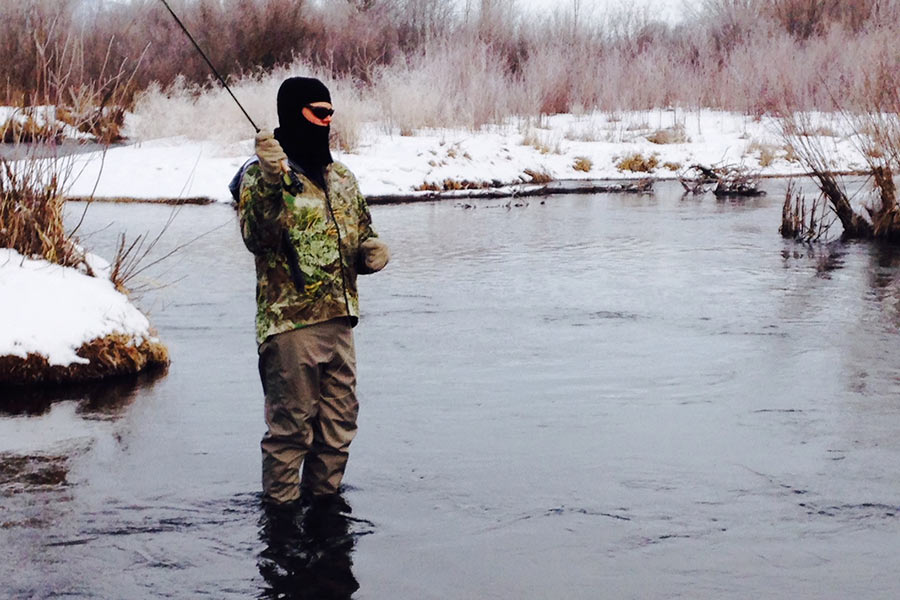3 great rivers to fish this winter
Salt Lake City — With shifting weather patterns and unstable ice conditions around the state, some anglers may think there are no opportunities for fishing this winter. However, streams and rivers can provide a great fishing experience during the winter, as well. Here are a few great fishing options for this time of year.
Blacksmith Fork River
Located in northern Utah, between Hyrum and Hardware Ranch, the Blacksmith Fork River is a nice, small stream that is easy to wade. It is not heavily fished and is managed so anglers can catch a lot of fish. It is also a good spot to catch a cutthroat trout (Bear River subspecies) for the Utah Cutthroat Slam or a hard-fighting brown trout. There is currently an overabundance of brown trout in Blacksmith Fork River, and the current fishing regulations allow anglers to keep an additional four brown trout caught there.
The Blacksmith Fork River provides opportunities for catching brown trout, Bear River cutthroat trout, mountain whitefish and rainbow trout, depending on what stretch of the river you are fishing.
Water levels and clarity are great on the river right now, and there isn't much ice currently. There is not a bait restriction on the river, so anglers can have success using nightcrawlers in pools and along the bank.
Lower Provo River
The lower section of the river runs through Provo Canyon and down into Utah Lake. It provides good fly fishing opportunities through the canyon and bait fishing opportunities below Olmstead Diversion and downstream through town. Anglers can catch a variety of species, including brown trout, rainbow trout, mountain whitefish and an occasional cutthroat trout, in the canyon and through town.
The lower Provo River is a popular fishing area and can be crowded during certain times of the year, but typically isn't during the winter months, making it a great time to fish there.
Duchesne River
There are a number of angler access points that are currently accessible along the Duchesne River — primarily the Blue Ribbon rated portion upstream of Hanna — that have provided good fishing this winter. The Duchesne River offers fishing for primarily brown trout and some rainbow trout.
Tips for river fishing during the winter
Anglers should dress in layers when fishing during the winter, and be prepared for very cold conditions, particularly if you are starting early in the morning. Always be extremely careful when fishing along streams with deep snow or icy conditions. Access can also be more of an issue during the winter, particularly if there is a lot of snow in the area. It's a good idea to check with the relevant land-managing agencies to see if the parking areas have been plowed, particularly if it has snowed recently.
Anglers should also be aware that fishing pole guides can start to freeze up after a while (particularly on really cold days), so make sure you have gloves on hand to remove the ice.
When finding fish in a river during the winter, there are a few things anglers should keep in mind.
"A fish's metabolism slows during the winter, so they will often spend time in slackwater areas to help them conserve energy," Utah Division of Wildlife Resources Northern Region Assistant Aquatics Manager Clint Brunson said. "Targeting pools and areas along river banks is often a good place to find the fish during winter months."
For lure anglers, a few different lures that often work well during the winter months include Panther Martins, Bluefox or Mepps, and small crankbaits in trout patterns. In areas where bait is allowed, jigs with a piece of nightcrawler can often be successful. For anyone fly fishing, you can often have success using small nymphs like Hare's Ear, pheasant tail, prince, sow bugs and zebra midges. One key is to get those nymphs near the bottom. Fish in the winter aren't as willing to swim or dart as far for food as they are when it is warmer.
"There is less for the fish to eat during the winter, but there are still bugs, so making sure you are using small flies and lures and getting them right in front of the fish will help you have more success," DWR Sportfish Coordinator Trina Hedrick said.
If you want to release the fish that you catch while fishing, there are a few things you can do to help decrease stress to the fish and increase survival. It's best to remove your gloves, which typically have absorptive fabric that can remove the protective slime coat from a fish's skin. You should also wet your hands when handling the fish and use a rubber net to more easily land the fish, so you can keep it in the water while removing the hook.
"Every second the fish is out of water is a second that it can't really breathe, so it's good to think about getting it back to the water and swimming freely as quickly as possible," Hedrick said. "With cooler temperatures, the fish will typically have less stress from the experience, but expediency is still key."

















